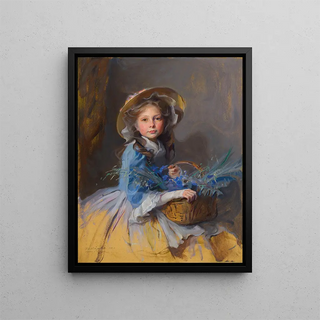Art print | Mrs Adrian van Montagu née Anne Mabel Olivia Trouton - Philip Alexius de László


View from behind

Frame (optional)
Mrs Adrian van Montagu née Anne Mabel Olivia Trouton Art print by Philip Alexius de László – Captivating introduction
In the fascinating world of portrait painting, the "Mrs Adrian van Montagu née Anne Mabel Olivia Trouton" art print by Philip Alexius de László stands out for its elegance and psychological depth. This portrait, created in the early 20th century, embodies not only the beauty of its subject but also the technical skill of the artist. László, known for his ability to capture the essence of his models, offers us here an intimate and refined vision of the woman he depicts. The work invites the viewer to delve into the universe of high British society of the time, while revealing subtle nuances of personality and character.
Style and uniqueness of the work
László's style is characterized by an exceptional mastery of chiaroscuro and meticulous attention to detail. In this portrait, the delicate features of Anne Mabel Olivia Trouton are rendered with striking precision, each shadow and light playing a crucial role in highlighting her face. The richness of textures, both in the depiction of clothing and skin, demonstrates unparalleled craftsmanship. The composition, carefully balanced, guides the viewer's gaze across the painting, creating a dynamic interaction between the subject and her environment. The choice of colors, both soft and vibrant, enhances the elegance of the central figure while adding an emotional dimension to the work. This portrait does not merely depict a woman; it captures an atmosphere, a period, and a sensibility that still resonate today.
The artist and his influence
Philip Alexius de László, of Hungarian origin, established himself as one of the most prominent portraitists of his time. His artistic journey, marked by rigorous training and diverse influences, shaped his unique approach to painting. László drew inspiration from old masters while developing a personal style that is entirely his own. His skill in representing the nobility and bourgeoisie of his era made him a preferred choice for portraits commissioned by prestigious clients. By integrating

Matte finish

View from behind

Frame (optional)
Mrs Adrian van Montagu née Anne Mabel Olivia Trouton Art print by Philip Alexius de László – Captivating introduction
In the fascinating world of portrait painting, the "Mrs Adrian van Montagu née Anne Mabel Olivia Trouton" art print by Philip Alexius de László stands out for its elegance and psychological depth. This portrait, created in the early 20th century, embodies not only the beauty of its subject but also the technical skill of the artist. László, known for his ability to capture the essence of his models, offers us here an intimate and refined vision of the woman he depicts. The work invites the viewer to delve into the universe of high British society of the time, while revealing subtle nuances of personality and character.
Style and uniqueness of the work
László's style is characterized by an exceptional mastery of chiaroscuro and meticulous attention to detail. In this portrait, the delicate features of Anne Mabel Olivia Trouton are rendered with striking precision, each shadow and light playing a crucial role in highlighting her face. The richness of textures, both in the depiction of clothing and skin, demonstrates unparalleled craftsmanship. The composition, carefully balanced, guides the viewer's gaze across the painting, creating a dynamic interaction between the subject and her environment. The choice of colors, both soft and vibrant, enhances the elegance of the central figure while adding an emotional dimension to the work. This portrait does not merely depict a woman; it captures an atmosphere, a period, and a sensibility that still resonate today.
The artist and his influence
Philip Alexius de László, of Hungarian origin, established himself as one of the most prominent portraitists of his time. His artistic journey, marked by rigorous training and diverse influences, shaped his unique approach to painting. László drew inspiration from old masters while developing a personal style that is entirely his own. His skill in representing the nobility and bourgeoisie of his era made him a preferred choice for portraits commissioned by prestigious clients. By integrating






